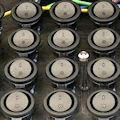Yocto-I2C and TSL2591
![]() Someone recently asked us how to interface an AMS TSL2591 ambient light sensor with the Yocto-I2C. It's an interesting question for two reasons: the TSL2591 is considerably more sensitive in low light than the Yocto-Light-V2 or the Yocto-Light-V3 and more particularly its I2C protocol is not the simplest to implement. It's an opportunity to test the limits of the Yocto-I2C autonomous job system.
Someone recently asked us how to interface an AMS TSL2591 ambient light sensor with the Yocto-I2C. It's an interesting question for two reasons: the TSL2591 is considerably more sensitive in low light than the Yocto-Light-V2 or the Yocto-Light-V3 and more particularly its I2C protocol is not the simplest to implement. It's an opportunity to test the limits of the Yocto-I2C autonomous job system.
| No comment yet | Read more... |
How to correctly measure ambient temperature
![]() Everyone knows that any measurement tends to disturb the physical quantity we are trying to measure. This issue is particularly blatant when you try to measure the temperature with a USB sensor. Some sensor types affect the temperature more than others, but there are ways to limit the problem. Let's look at this in more details...
Everyone knows that any measurement tends to disturb the physical quantity we are trying to measure. This issue is particularly blatant when you try to measure the temperature with a USB sensor. Some sensor types affect the temperature more than others, but there are ways to limit the problem. Let's look at this in more details...
| No comment yet | Read more... |
Interfacing the SPS30 particle sensor
![]() Sensirion recently released the SPS30, a particulate matter sensor with both a serial interface and an I2C interface. So, obviously, we didn't have to wait for long before someone asked us whether we could interface it with Yoctopuce modules.
Sensirion recently released the SPS30, a particulate matter sensor with both a serial interface and an I2C interface. So, obviously, we didn't have to wait for long before someone asked us whether we could interface it with Yoctopuce modules.
| No comment yet | Read more... |
How to measure the state of many buttons
 If you have already tried to build a control panel interfaced by USB with many ON/OFF buttons, you know that it's not as simple as it may seem. Not only the multiplication of buttons makes the wiring process quickly complex, but if you are limited to 5 or 8 inputs per module, the number of interface modules that you must use increases rapidly. A way to improve these two issues consists in multiplexing several buttons on a single analog interface, and this is what we are going to show you today.
If you have already tried to build a control panel interfaced by USB with many ON/OFF buttons, you know that it's not as simple as it may seem. Not only the multiplication of buttons makes the wiring process quickly complex, but if you are limited to 5 or 8 inputs per module, the number of interface modules that you must use increases rapidly. A way to improve these two issues consists in multiplexing several buttons on a single analog interface, and this is what we are going to show you today.
| No comment yet | Read more... |
Measuring time-encoded signals
![]() While we were making improvements to the Yocto-PWM-Rx for our previous post, we noticed that this device has considerably changed since its conception in order to cover more use cases than the once planned initially. To help you navigate into all these possibilities, we summarize in this post the different working modes.
While we were making improvements to the Yocto-PWM-Rx for our previous post, we noticed that this device has considerably changed since its conception in order to cover more use cases than the once planned initially. To help you navigate into all these possibilities, we summarize in this post the different working modes.
| No comment yet | Read more... |


